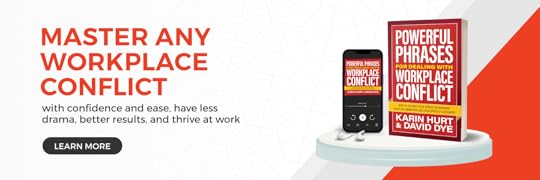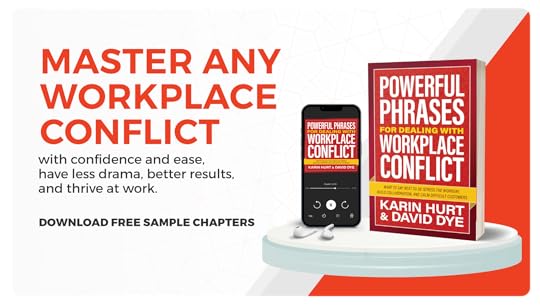David Dye's Blog, page 23
March 11, 2024
Better Stakeholder Management: How to Turn Stress into Success
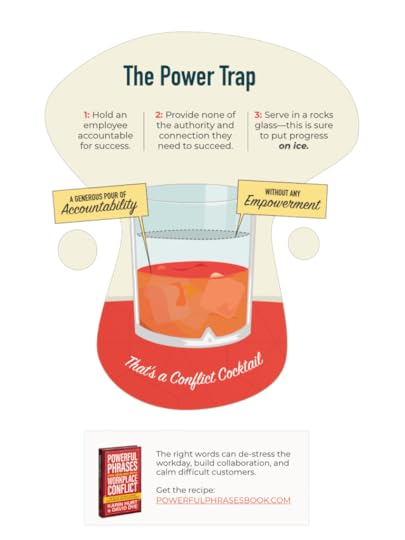 Use these communication techniques to keep even the most difficult stakeholders on your side
Use these communication techniques to keep even the most difficult stakeholders on your sideStakeholder management is an art most of us learn the hard way. This article gives you some practical tips for better influence and less stress.
Sound familiar?You glance at your phone, and your heart does a mini samba. It’s Last Minute Linda. The clock’s ticking down to your big presentation, and Linda decides now is the perfect time for her “Eureka” moment. Sure, you’re all for ideas and collective wisdom, but why couldn’t this epiphany have struck a week ago?
Just then you open your email there are five separate notes from Nervous Nora, asking you a whole series of “have you thought abouts…?” (which you have).
Then Can’t Commit Carl texts with another curveball asking you to postpone the meeting another week to give him some more time to think this through.
Oh, and here comes Over-Involved Ivan, who has taken the liberty of setting up a few extra focus groups (talking to the same people you did last week).
If you’ve been involved in stakeholder management for more than a minute, you’ve probably met a few of these well-meaning, challenging stakeholders.
Effective Strategies for Better Stakeholder ManagementHere are a few approaches and what to say to destress your day, and keep your project on track.
1. Focus on Being Effective, Not RightSet aside right, and focus on how you can be effective with your difficult stakeholders.
If Distracted Donna is feeling stressed and slowing you down by asking for information you’ve already shared, then the way you’ve been communicating isn’t working. You may have been “right” in that you updated her and she wasn’t listening, but you haven’t yet been effective.
You might say,
What if we set up a 15-minute check-in each week so I can give you exactly what you need? If we don’t have an important update, I’ll cancel it and send you a quick email.”Nora may be anxious because she’s uncertain about outcomes. You might be “right” in telling her everything is under control, but you become “effective” when you present her with a contingency plan. This eases her anxieties and wins you a cooperative stakeholder.
You could approach Nora this way:
You’re raising some important concerns and I’ve thought about that too. Let me walk you through a few of our contingency plans. I want to ensure we’re addressing any of your big concerns.”2. Pause to Breathe, Then ProceedOne particularly difficult aspect of stakeholder management is when your stakeholders get mean or cranky.
When you feel attacked, overlooked, slighted, ignored, devalued, or taken for granted it’s normal to be angry and ask “Why are they doing this to me?”
Take a moment to breathe and remind yourself that the other person’s actions aren’t about you. They’re trying to do the best they can with what they have. They didn’t wake up that morning thinking about how to make you angry.
If you need to take a few minutes to collect yourself, do it. You’re better off entering the conversation in a calm state of mind.
When emotions run high, clarity suffers. Take a moment to breathe, put emotions aside, and strategize calmly.
One stakeholder management superpower is knowing how to de-escalate a conversation. Here are a few powerful phrases that can help.
“I noticed that . . . What’s happening for you?”One option is to observe what’s happening. When you calmly call attention to someone’s behavior and ask, “What’s happening for you?” it helps them take a breath and choose a different approach. For example, you might say, “I notice that you’re standing up and yelling. What’s going on for you right now?
“I appreciate you sharing that with me.”This simple sentence works wonders in many stakeholder management scenarios. It works best when someone has shared a difficult perspective—something that they expect you won’t like. You’re not agreeing or disagreeing. Rather, you’re honoring their effort at communicating. It can also be a good way to take a pause in an ongoing conversation, so you have time to think about their perspective.
“How about a timeout?”Sometimes you’ll need to call a timeout and give everyone time to calm down. Sometimes, when trust is very low, you might need to bring a third party or an advocate the other person trusts into the conversation to help moderate.
3. Engage with EmpathyEmpathy is the most effective way to help you become more effective in your quest for stakeholder management. Try to see the world from their perspective. When you can understand why they act the way they do, you are in a better position to come up with constructive solutions.
Perhaps Distracted Donna is juggling three major strategic initiatives that consume her attention. Or, Can’t Commit Carl lives in the mental world of opportunity and “What could be” and doesn’t feel tied down by arbitrary due dates. He also cares – a lot.
Maybe Over-Involved Ivan has seen this movie before and it ended with him in a cameo role as “The Micromanager Who Knew Too Much.”
If you’re not sure what the world looks like from their perspective, you can always ask. eg: “What is most important about this assignment? I want to make sure we nail it – can you help me understand how this fits into the big picture?”
A few of our GOAT (Greatest of All Time) Powerful Phrases from our new book, Powerful Phrases for Dealing With Workplace Conflict, work well to express empathy and create a connection with your difficult stakeholder.
“I care about _____ (you, this team, this project) and I’m confident we can find a solution that we can all work with.”Of course, this one requires sincerity. If your past behavior makes this statement questionable, you’ll want to supplement this one with a sincere apology as you state your intent for your future relationship.
“Tell me more.”Nothing builds a connection like being seen, and this Powerful Phrase gets there in just three words. This prompt helps move through surface conversation and symptoms to deeper meaning. When you invite the other person to continue, they’ll often help you understand what they really want to say, what matters most to them, and you’ll avoid misunderstandings.
“It sounds like you’re feeling _____ is that right? [pause for affirmation]. Thank you for letting me know how you feel.”Checking in with the other person to validate their feelings can help deescalate a conflict at any point in the conversation.
4. Seek Self-AwarenessOne vital secret to effective stakeholder management is that they’re not the only “difficult” person in the mix. From their perspective, you might be the difficult one. We’re all someone else’s knucklehead.
In Over-Involved Ivan’s eyes, you might be the one not paying enough attention to detail. Counteract this by showing him that you do care about the minutiae, but also explain how zooming out to see the big picture can be equally crucial.
You might tell Ivan,
“I value your perspective. Could we schedule a quick meeting to discuss how things are going?”Or, “I appreciate your attention to detail, Ivan. I see why this particular point is a concern for you. However, if we focus too much on this, we risk losing sight of other essential aspects.”5. Inform IntelligentlyDifferent people need different information – differently. Remember, you want to be effective, not right. It does no good to send a monthly email when you know your key stakeholder receives information verbally and can give you a response quickly if you just walk down the hall or pick up your phone.
Do they need the full backstory or a quick summary of what happened and what you need? Do they want hourly updates or a weekly summary? Give people the information they need in the way they need it and your relationship will improve.
This is where many leaders get caught in the trap of being “right” but not effective. Just because you sent an email doesn’t mean you’ve communicated.
6. Plan EngagementWhen you know that a key stakeholder is likely to engage too late, too often, or not at all, you can plan an intentional way to get their attention and input.
For someone like Linda. who you know will wait until the last minute to get involved, move the finish line. Specifically, seek her out and schedule a check-in before the final deadline.
You might ask Linda,
“Can we talk for five minutes – you’ve got something valuable to offer here.”Tell her how much you value her perspective, and that you would love her input. If she doesn’t have thoughts now, give her a deadline that still allows you to get it done.
Yes, it takes a little extra effort compared to the place where everyone else is contributing, but the alternative is that dreaded phone call the night before. Savvy leaders know their stakeholders and get them involved when it makes the most sense.
For Nervous Nora and Over-involved Ivan: Sometimes, cutting through the ambiguity is the best approach. A candid conversation about expectations and worries can often set the stage for smoother interactions ahead.
“What would a successful outcome do for you?”A Recipe for SuccessEffective stakeholder management isn’t just about avoiding pitfalls; it’s about proactively transforming challenges into opportunities for growth and influence.
Your turn.What are your best practices for dealing with difficult stakeholders?Want more powerful phrases for dealing with tricky situations and difficult stakeholders?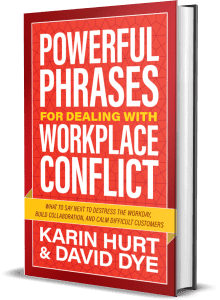 If you’ve noticed we’ve been talking about workplace conflict and collaboration a lot recently, it’s because we’ve been doing a lot of research, learning from people all over the world about their biggest workplace conflicts and what they would do differently next time. More on that research here.
If you’ve noticed we’ve been talking about workplace conflict and collaboration a lot recently, it’s because we’ve been doing a lot of research, learning from people all over the world about their biggest workplace conflicts and what they would do differently next time. More on that research here.
In the meantime, our new book, Powerful Phrases for Dealing with Workplace Conflict: What to Say Next to Destress the Workday, Build Collaboration, and Calm Difficult Customers is AVAILABLE FOR PRE-ORDER NOW, and we’re working on building our speaking tour for Spring 2024 (you can take a quick peek at some of our new conflict and collaboration programs here).
The post Better Stakeholder Management: How to Turn Stress into Success appeared first on Let's Grow Leaders.
March 8, 2024
Unlock Team Success with Proven Strategies to Build a Better Team
Episode 247: In this episode, Tanya Luna discusses the principles of power with and how to a build better team. She emphasizes the importance of following a purpose rather than a person, relying on context instead of control, being a cultivator rather than a collector, and building a community rather than a crowd. Luna suggests implementing these principles by providing clear context and purpose for roles, allowing individuals to self-evaluate their progress, and creating opportunities for feedback and collaboration. She also advises starting small and gradually expanding these practices throughout the organization.
Building a Better Team with Tanya Luna[00:00] The conversation begins with a powerful notion: shifting focus from personal ambition to collective success. Embracing a shared purpose paves the way for a culture of learning and growth, essential for cultivating a better team.
[00:14] David introduces “Leadership Without Losing Your Soul,” setting the scene for an insightful dialogue on achieving transformational results in leadership while maintaining one’s humanity and mental well-being—a crucial balance for fostering a cohesive team.
[02:16] The introduction of Tanya Luna, highlighting her ventures and the book “Lead Together,” underscores her commitment to innovative leadership principles and the creation of humane workplaces. This philosophy is central to building a better team through mutual respect and shared objectives.
[04:14] Reflecting on leadership as a continuous journey of growth and adaptation, the conversation underscores the importance of flexibility and learning in the quest to build a more effective team.
[05:20] The discussion delves into the dynamics of power within leadership, advocating for a “power with” rather than a “power over” approach. This concept is key to developing a better team environment, where power is utilized collaboratively towards achieving shared goals.
[08:21] Through the allegorical journey of Sam the squirrel, listeners are introduced to real-life leadership challenges. Sam’s experiences mirror the lessons in embracing shared power and resilience, which are vital in the journey of building a more cohesive team.
Unleashing Collective Power Through Leadership[11:53] Tanya shares her personal challenges and triumphs in leadership during the pandemic, illustrating the strength of a collaborative approach in crisis management. This story highlights the importance of shared decision-making in creating a resilient and better team.
[15:09] Exploring the concept of power in detail, the dialogue emphasizes the need for a balance between empowering individuals and ensuring power is not concentrated. Achieving this balance is fundamental for nurturing a well-functioning, empowered team.
[20:53] By unfolding Sam’s story further, key leadership principles such as aligning with a purpose and prioritizing context over control are brought to light. These principles form the cornerstone of the philosophy for building a better team, guided by shared goals and a clear understanding of decision-making rationales.
[33:10] The final part of the conversation addresses practical applications of these leadership principles in various organizational settings. This segment wraps up the journey towards building a better, more empowered team by highlighting the challenges and successes of implementing a collaborative leadership model.
Through this engaging dialogue, David and Tanya Luna navigate the intricacies of leadership, focusing on the transformative impact of shared goals, mutual support, and collective empowerment in building a better team.
Thank You to Our GuestTANIA LUNA, author of LEAD TOGETHER: Stop Squirreling Away Power and Build a Better Team, is an entrepreneur, psychology researcher, and writer. She has founded and grown multiple companies, including Scarlet Spark, a nonprofit that creates human-friendly workplaces for organizations that help animals, and LifeLabs Learning, a leadership development company.
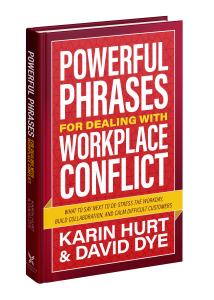 If you’d like more specific, practical phrases and approaches for common sources of workplace conflict, check out our newest book (May 2024—available for pre-order now): Powerful Phrases for Dealing with Workplace Conflict—What to say next to de-stress the workplace, build collaboration, and calm difficult customers.
If you’d like more specific, practical phrases and approaches for common sources of workplace conflict, check out our newest book (May 2024—available for pre-order now): Powerful Phrases for Dealing with Workplace Conflict—What to say next to de-stress the workplace, build collaboration, and calm difficult customers.
The post Unlock Team Success with Proven Strategies to Build a Better Team appeared first on Let's Grow Leaders.
March 4, 2024
Stop Right There! 5 Phrases that Crush Collaboration and Tank Teamwork
You didn’t mean to tick them off, but here you are. Your words backfiring like a faulty engine, and now a cloud of awkwardness fills the room. You know collaboration matters and you want to be a team player. So what went wrong?
5 Phrases to Avoid if You Want Better Collaboration on Your TeamLet’s talk about some of the most common phrases that sabotage collaboration, why they’re so annoying, and what to do instead.
1. Let’s Agree to DisagreeIn the realm of collaboration, “Let’s Agree to Disagree” is basically your team’s attempt at taking a shortcut around a gnarly problem—except this shortcut leads straight into a brick wall painted like a tunnel à la Wile E. Coyote. You’re not solving anything. What you’re really saying is, “I value the absence of conflict more than I value arriving at a shared solution.”
Sure, it momentarily saves face, avoids immediate friction, and allows everyone to sidestep the awkwardness—but it also bookmarks that problem for a sequel. Now you’ve got an unresolved issue lurking in the background like an unopened email forever marked as ‘important’ but never read.
Instead of closing the door on discussion, why not keep it ajar for more ideas, refinements, and maybe—just maybe—finding a path to team unity that doesn’t involve mutual evasion tactics?
If you’re looking for some additional confidence and conversation starters see, Let’s Talk About It: How to Start the Conversation Everyone Wants to Avoid.
And a few of our Powerful Phrases G.O.A.T.s work great here too. For example:
“I care about _____ (you, this team, this project) and I’m confident we can find a solution that we can all work with.” or “Let’s start with what we agree on.”
2. It’s Too Late to Change Course NowThis phrase acts like quicksand for team progress, promoting a fixed and inflexible approach that could stifle innovation and adaptability. By saying it’s too late to change course, the team shuts down opportunities to adapt to new circumstances or pivot based on fresh insights. It can trap the team in a “sunk cost fallacy,” escalating commitments to failing or suboptimal projects. The phrase discourages reevaluation and course correction, which are often necessary for fast-paced, ever-changing landscapes.
Curiosity powerful phrases work great here.
“I know we’ve already invested a lot here, and changing course would be rough. But I’m curious about what you’re thinking. Can you tell me more?”
See Also: How to Not Be Perceived as Negative at Work.
3. I’ve Done My Part, The Rest Is Up to YouThis phrase sounds like a benign statement of task completion, but its impact is anything but. It subtly erodes the sense of collective ownership and accountability that are vital for effective teamwork. By declaring that one has “done their part,” it implies a disinterest in the project’s broader success and fosters a culture of siloed responsibilities. This can be detrimental to team morale and unity, as it signals a lack of engagement with the project’s overall objectives. Moreover, it inhibits cross-functional collaboration and skill-sharing, ultimately limiting the team’s versatility and adaptability.
Instead try, “What can I do to be helpful here?”
4. That’s a Terrible IdeaYou’re not Simon Cowell judging amateur karaoke, and even if you were, every idea has some merit. In an era of disruptions and paradigm shifts, the ‘terrible’ idea you scoff at could well be the next big thing. Instead of shutting down your colleagues, respond with regard, with gratitude, information, and an invitation to continue contribution.
For more on responding well and getting more remarkable ideas, you might want to take a peek at Karin’s popular TEDx talk, The Secret to Getting Remarkable Ideas You Can Actually Use.
5. We don’t have time for thisOf course, it might be true. You might not have time to talk about their idea or suggestion right now. And, if you want better collaboration, consider how you can keep the conversation on track while being respectful of what your teammates want to say.
Instead, you might try a few of these phrases for better collaboration.
“This is an important topic; let’s schedule a dedicated meeting to discuss it.”
“I understand this is a key issue. Can you summarize it in a few points, and then we’ll decide on the best time to dig deeper?”
“Let’s identify the most immediate priorities for today’s meeting, and make sure we allocate time for this in the near future.”
This one is a proactive approach that involves the team in prioritizing tasks, including the issue brought up, for future discussions.
In conclusion, the next time you find these phrases slipping off the tip of your tongue, pause. Replace them with phrases that promote an atmosphere of innovation, openness, and collaboration. It’s not just about keeping up with the buzzwords; it’s about fostering a culture where everyone’s a buzz-worthy contributor.
Coming This Spring (Available for Pre-Order Now) If you’ve noticed we’ve been talking about workplace conflict and collaboration a lot recently, it’s because we’ve been doing a lot of research, learning from people all over the world about their biggest workplace conflicts and what they would do differently next time. More on that research here.
If you’ve noticed we’ve been talking about workplace conflict and collaboration a lot recently, it’s because we’ve been doing a lot of research, learning from people all over the world about their biggest workplace conflicts and what they would do differently next time. More on that research here.
In the meantime, our new book, Powerful Phrases for Dealing with Workplace Conflict: What to Say Next to Destress the Workday, Build Collaboration, and Calm Difficult Customers is available for pre-order now, and we’re working on building our speaking tour for Spring 2024 (you can take a quick peek at some of our new conflict and collaboration programs here).
The post Stop Right There! 5 Phrases that Crush Collaboration and Tank Teamwork appeared first on Let's Grow Leaders.
March 1, 2024
Putting People First: The Promise of Human Centered Capitalism
Episode 246: Megan Gluth-Bohan, CEO & Owner of TRInternational, Inc. and owner of ChemBlend of America, discusses human centered capital, and the importance of compassion, empathy, and resilience in leadership. She emphasizes the need for leaders to be authentic and honest about their own experiences and to create a culture that values and supports the growth of individuals. Bohan believes in hiring based on potential and drive rather than solely focusing on past achievements. She also emphasizes the importance of accountability and recovery when mistakes are made, encouraging leaders to acknowledge the mistake, apologize, and then focus on finding a solution. Bohan believes that leaders should prioritize self-care and personal growth in order to be effective in their roles. She also highlights the challenges of finding and retaining talent in today’s workforce and the need for leaders to balance accountability with empathy.
The Journey to Human Centered Capitalism00:10 Megan discusses her journey from being kicked out of college to achieving significant entrepreneurial milestones. She attributes her success to embracing every part of her past, a belief that reveals the essence of a leadership style that treats setbacks as stepping stones.
01:43 Megan reflects on her role as a big sister, her earliest experience with leadership. This familial role taught her to lead with compassion and understanding, elements that later became crucial in her professional life.
Navigating Crisis with Resilience03:22 Megan introduces her companies pivotal role in the global supply chain, highlighting the company’s commitment to innovation and resilience—a reflection of the human centered approach to business.
05:27 Megan delves into the complexities of managing supply chain crises. Her approach underscores the necessity of resilience in leadership, a key component of effective management.
Embracing Vulnerability and Intuition in Leadership06:33 Megan candidly shares her personal struggles, including her battle with addiction. This vulnerability speaks to the heart of her leadership philosophy, which recognizes the strength that can come from life’s challenges.
10:59 She speaks about the paramount importance of leading oneself, emphasizing that personal integrity and self-awareness are prerequisites to leading others and a testament to the philosophy of putting people first.
Cultivating Empathy and Potential in the Workplace16:22 Megan explains how her intuition has informed her business decisions, allowing her to lead in a way that honors the individual strengths of her team members.
19:53 She discusses how she builds a culture that focuses on the potential of her employees rather than their pasts. This approach not only nurtures growth but also aligns with the idea of valuing human capital.
Candid Communication: A Strategy for Human Centered Capital27:09 Megan’s belief in open communication is highlighted when she shares how being direct and transparent with her team builds trust and establishes clear expectations.
36:56 Megan stresses the importance of self-care. She argues that a leader’s first responsibility is to themselves, advocating for a lifestyle that prepares them to lead others more effectively.
Through this podcast, Megan Gluth-Bohan illustrates the multifaceted nature of human centered capital and how it permeates every aspect of effective leadership and organizational success.
Thank You To Our GuestsMegan Gluth-Bohan is the owner and CEO of TRInternational, a US-based chemical distributor, and the Owner of Chemblend of America, a chemical blending and tolling facility. TRI is one of the largest certified women-owned suppliers in North America.
 If you’d like more specific, practical phrases and approaches for common sources of workplace conflict, check out our newest book (May 2024—available for pre-order now): Powerful Phrases for Dealing with Workplace Conflict—What to say next to de-stress the workplace, build collaboration, and calm difficult customers.
If you’d like more specific, practical phrases and approaches for common sources of workplace conflict, check out our newest book (May 2024—available for pre-order now): Powerful Phrases for Dealing with Workplace Conflict—What to say next to de-stress the workplace, build collaboration, and calm difficult customers.
The post Putting People First: The Promise of Human Centered Capitalism appeared first on Let's Grow Leaders.
February 26, 2024
Create Commitment: 12 Habits to Build Agreement and Accountability
 Commitment is vital to effective teamwork, collaboration, and results.
Commitment is vital to effective teamwork, collaboration, and results.One of the most frustrating aspects of teamwork is the feeling of futility – of spinning your wheels. You connect with one another, establish clear success criteria, get curious, and build on one another’s suggestions, but nothing happens. Your conversation needs to produce action, or nothing changes. And if nothing changes, it’s worse than if you never had a conversation. Now you’ve wasted time, trust drips away, and people lose hope. The answer is to build shared agreements – commitments – that move you from words to action. In this final installment of our “Great Teamwork Series” we share 12 collaboration habits to create commitment and build momentum with follow through and results.
12 Habits Great Teams Consistently Do to Create Commitment and Build Collaboration1. Ignite Action: Turn intentions into activities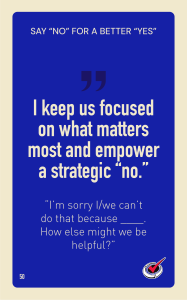
Habit: I get things going—moving the conversation to create specific plans
When your team has tight conversations that lead to meaningful results, trust and morale improve along with the team’s capacity to make even more meaningful decisions. You can help your team avoid endless discussions, analysis paralysis, and chokepoints by moving conversations to intentions to specific actions.
Related Article: Help Your Team Do More-Stop (over) Talking and Start Doing
2. Say “No” for a Better Yes: Explain tradeoffs and gracefully decline opportunities that derail critical effortHabit: I keep us focused on what matters most and empower a strategic “no.”
Related Article: How to Say No at Work: Powerful Phrases to Stand your Ground
It’s never easy to say no at work. After all, you want to be helpful, responsive, and a team player. And yet, every time you say “yes” to something or someone, you’re saying “no” to something or someone else. One way to help one another create commitment and say no effectively is to start with a “yes.” Do this is by affirming the request and the value the request might represent—that’s the “yes.” Then bridge to the context, consequences, and decisions—that’s the “no.”
3. Keep Things Organized: Provide structure the team needs to work efficiently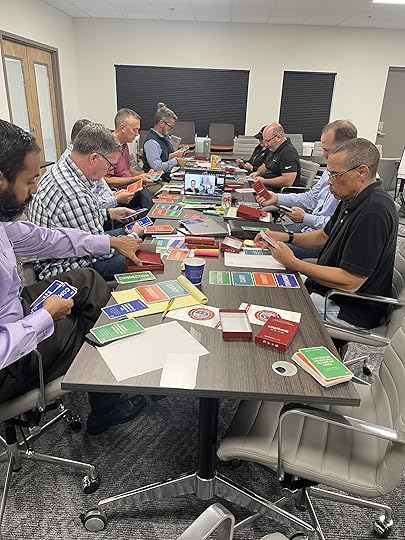
Learn about our SynergyStack collaboration programs. Contact us at info@letsgrowleaders.com
Habit: I make it easy to collaborate and integrate our work.
Can everyone find the information, tools, and data they need to do their work? If not, you’re wasting time interrupting each other asking for what you need or in frustrating fruitless searches. A little organization will help everyone work more efficiently. (Just avoid the temptation to over-organize. You’ll know this happens when you spend more time on the organization system than you do on your actual work.)
4. Create Ownership: Verify that every task has a specific person responsible for its completionHabit: I ensure we conclude our meetings or conversations by clarifying responsibility.
When everyone’s responsible, no one is. Guarantee that any conversation requiring action ends with a specific person taking responsibility to follow through on an assignment. The project may require a team. But one person has ownership and responsibility to follow through.
5. Respect Confidentiality: Build trust with appropriate discretion and privacyHabit: I protect sensitive information.
Related Article: Confidential Information – What to Say When You Can’t Say Anything
It can be tempting to share private information. It feels like a shortcut to building intimacy and connection. But every time you violate confidentiality, you tell the person you’re talking to that they can’t trust you with critical information. When you can’t share information, be honest about it. For example, “That’s not something I can talk about. It’s important that to me you can trust that if we’re ever in a similar situation, I won’t talk about it then either.”
6. Schedule the Finish: Create shared appointments to meet, discuss, and conclude tasksHabit: I confirm specific deliverables and timeframes for when we will follow up on our commitments.
You’ve got more to do than time to do it. Your plan is going to get interrupted, and your interruptions are going to get interrupted. If you don’t have an intentional, focused way to finish what you start, it won’t happen. Effective teams consistently achieve meaningful results and build a healthy culture–but they don’t leave it to chance or a heroic act of willpower. They create commitment by scheduling the finish with specific, shared appointments to follow through. These conversations consider competing priorities and adjust accordingly.
Related Article: High ROI Leadership: Schedule the Finish
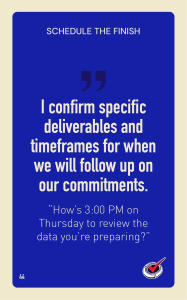 7. Hold Others Accountable: Practice peer-to-peer check-ins and closure
7. Hold Others Accountable: Practice peer-to-peer check-ins and closureHabit: When people don’t follow through, I follow up with them.
Look at the research about high-performing teams and one universal characteristic jumps out. In high-performing teams, accountability isn’t just the manager’s job—the team holds one another accountable (and their manager too). When you talk to high-performing teams, it’s easy to see that this team accountability doesn’t just happen. They work at it. Help your team succeed by following up and creating closure for commitments.
Related Article: Great Teams Hold One Another Accountable (You Can Too).
8. Honor Deadlines: Get work done on time and watch out for barriersHabit: I take our commitments seriously, and proactively talk about obstacles that might derail our deliverables.
The distractions that creep up and disrupt our follow through feel like a surprise. But are they really? When you lift your gaze, look outward and ask “is there anything that could prevent us from making this commitment?” you can help your team anticipate and deal with these disruptions before they interfere with your focus.
9. Keep My Team on Track: Help your colleagues maintain focus and avoid distractionsHabit: I ensure our team meets our obligations together.
One of the most tempting distractions that can take you and your team off track is other meaningful work. That new shiny assignment may be great for your career – and so is delivering the results you’ve promised. You can help your team maintain focus and a manageable workload by suggesting “Let’s get this done before we take on that new project.”
Related Article: Get Your Team Back on Track: Leading Through Distractions
10. Do What I Say: Keep your commitmentsHabit: I follow through and keep my word.
Can your team rely on you? Your reliability directly affects your team’s trust in you. Can they rely on one another? Often, when reliability breaks down, it’s not because people lack integrity, it’s because they said “yes” to something without fully thinking through what it would take to keep that commitment. You can increase your reliability by consistently scheduling the finish and discussing tradeoffs. (See #2 and #6 above.)
11. Speak with Candor: Give the gift of truth, spoken gracefully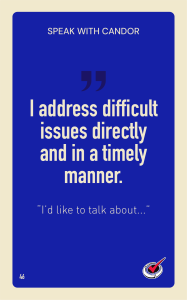
Habit: I address difficult issues directly and in a timely manner.
Direct, honest communication helps everyone know where they stand and minimizes drama within your team. The earlier you address challenging situations, the easier they are to resolve.
12. Celebrate Success: Acknowledge wins in all their formsHabit: I acknowledge wins, progress and learning.
You get more of what you encourage and celebrate, so take time to recognize all that you and your team have achieved together. You can do this in the middle of projects to energize one another for the road ahead. Pay attention to the different forms of “wins” – it’s not just successful completion. You can celebrate learning, progress, and improved capacity.
Related Articles: True Gratitude: More Than Pleasantries or Recognition and Leading Through Rapidly Changing Priorities
13. Your Turn: What habit would you add to create commitment and build shared agreements?Note: This article is part four of our 4-part Better Teamwork Series. Find the other parts here:
Better Teamwork: 12 Practical Habits to Build Deeper ConnectionGreat Teams: 12 Practical Collaboration Habits to Create ClarityCreative Teams: 12 Habits that Foster Curiosity and CollaborationComing This Spring (Available for Pre-Order Now)Our new book, Powerful Phrases for Dealing with Workplace Conflict: What to Say Next to Destress the Workday, Build Collaboration, and Calm Difficult Customers is available for pre-order now, And, we’re working on building our speaking tour for Spring 2024 (you can take a quick peek at some of our new conflict and collaboration programs here).
The post Create Commitment: 12 Habits to Build Agreement and Accountability appeared first on Let's Grow Leaders.
February 23, 2024
Optimize Leadership Potential While Navigating the Complexities of a Hybrid Work Environment
Episode 245: In this podcast episode, Felice Eckelman and Julie Cantor discuss the challenges and strategies for leading in a hybrid work environment. They emphasize the importance of intentionality in developing policies and creating connections among team members. They also address the need for training leaders to recognize and address bias, as well as the importance of setting boundaries and managing zoom fatigue. The speakers provide practical suggestions for building connections, establishing policies, and promoting mental health and wellness. They also highlight the potential legal risks and the need for consistency in policy implementation. Overall, the episode emphasizes the need for leaders to be proactive and intentional in navigating the complexities of a hybrid workplace.
Navigating the Hybrid Work Environment: A Leadership Journey[00:00] The Essence of Inclusive Policy-Making
It’s essential that the policy-making team steps out of isolation. Engaging a diverse range of voices ensures that policies resonate with everyone, reinforcing the importance of consistency and mitigating legal risks.
[01:29] The Balance of Home and Office
Felice and Julie, experts in navigating hybrid workplaces, share their experiences of the delicate dance between home and office commitments, highlighting the hybrid work environment’s flexibility.
[03:28] Leadership Lessons from Unexpected Places
Reflecting on past leadership roles, Julie and Felice draw parallels with today’s hybrid work environment, emphasizing the value of face-to-face interactions for fostering team spirit and learning.
[06:50] Defining Hybrid Work
The hybrid work environment is a flexible arrangement where employees may have varied in-office schedules. Leaders face the challenge of managing teams that are sometimes remote, sometimes on-site, highlighting the need for intentional engagement strategies.
[14:00] Crafting Intentional Hybrid Policies
Creating an effective hybrid work policy requires considering the ‘why’ behind in-office requirements. It’s about quality interactions over quantity, ensuring that employees’ time in the office is meaningful and productive.
[17:22] The Importance of Intentionality in Hybrid Work
In a hybrid work environment, intentionality means understanding the value of in-office collaboration. Leaders must convey the ‘why’ behind physical presence to maintain a fair and inclusive workplace.
[24:00] Cultivating Connections in a Hybrid Setting
Fostering connections in a hybrid work environment involves intentional pre-meeting interactions and structured social opportunities. These create the interpersonal glue that strengthens team cohesion.
[33:25] Training Leaders for Hybrid Challenges
Training leaders to recognize and combat bias is crucial. This ensures fair treatment across different working arrangements and generational preferences, fostering inclusivity.
[37:51] Managing Stress and Boundaries in Hybrid Work
Balancing work and personal life in a hybrid setting requires clear boundaries. Leaders and employees must collaborate to establish communication norms that protect mental health and support productivity.
[42:13] Harnessing Intentional Transitions and Boundaries
Intentional transitions between work and personal life are vital in a hybrid work environment. Leaders must guide employees to set boundaries that promote mental well-being and prevent burnout.
As we navigate the complexities of hybrid work environments, these insights remind us that intentionality, inclusivity, and connection are the cornerstones of successful leadership.
Thank You To Our Guests –Connect with Felice Eckelman and Julie Cantor or order their book.
 If you’d like more specific, practical phrases and approaches for common sources of workplace conflict, check out our newest book (May 2024—available for pre-order now): Powerful Phrases for Dealing with Workplace Conflict—What to say next to de-stress the workplace, build collaboration, and calm difficult customers.
If you’d like more specific, practical phrases and approaches for common sources of workplace conflict, check out our newest book (May 2024—available for pre-order now): Powerful Phrases for Dealing with Workplace Conflict—What to say next to de-stress the workplace, build collaboration, and calm difficult customers.
The post Optimize Leadership Potential While Navigating the Complexities of a Hybrid Work Environment appeared first on Let's Grow Leaders.
February 22, 2024
How Do I Build Better Leadership Trust on my Team
Leadership trust begets trust.
“It’s possible to have two trustworthy people working together, both trustworthy and yet, no trust between them.” – Stephen M.R. Covey.
I was delighted to have this important conversation with Stephen M. R. Covey where we both keynoted the Northview Church LEADS Conference. The conference was all about COURAGEOUS leadership. This concept is something I believe so deeply. If you want people to trust you, you’ve got to trust them.
Stephen shares, “If the outcome you want is trust, a high trust team, high trust culture, yes, we have to be trustworthy. We earn that. But we also have to be trusting. It’s the combination of being both trustworthy and trusting. It creates trust. I find bigger gaps and creating trust in teams and organizations is less that people aren’t trustworthy. Although, sometimes, that’s the case. And it’s more often that we’re not trusting.”
Leaders go first. Watch this #askingforafriend video for PRACTICAL tips to do this well, as well as some practical ways to restore leadership trust once it’s broken.

It seems kind of wonky right? How can two trustworthy people not trust one another? Stephen M.R. Covey shares how. Sometimes it is not about whether they trust you. It could be whether you trust them.
Building a Culture of TrustCreating a culture of leadership trust requires courage, openness, and a commitment to transparency. Here are some steps you can take to cultivate leadership trust:
Demonstrate Trust: Leaders must lead by example. Show trust in your team’s abilities and decisions. This act of faith encourages a reciprocal response, fostering a supportive and trusting team dynamic.Communicate Openly: Open lines of communication are the backbone of leadership trust. Encourage honest dialogue, share information freely, and address concerns and misunderstandings promptly.Acknowledge Vulnerability: Admitting mistakes and showing vulnerability are powerful trust builders. They humanize you, making you more relatable and trustworthy.Empower Others: Trusting your team with responsibilities and decision-making authority empowers them and boosts their confidence. It also signals your leadership trust in their capabilities, further solidifying the trust foundation.Restoring Broken Leadership TrustMistakes happen, and leadership trust can be broken. To fix it, acknowledge the mistake, apologize, and take tangible steps to rebuild the trust. This process is neither quick nor easy, but with patience and consistency, it is possible to mend fences and strengthen relationships.
The Ripple EffectThe benefits of a high-trust environment extend far beyond the immediate team or organization. Leadership trust fosters innovation, enhances collaboration, and improves overall performance. Moreover, it contributes to a positive organizational culture that attracts and retains talent.
The conversation with Stephen M.R. Covey underscores a critical lesson: Trust is both a gift and a responsibility. It demands a delicate balance of being trustworthy and being willing to trust others. By embracing this dual approach, you can unlock the full potential of your team and pave the way for transformative change.
Powerful Phrases to Navigate Conflict and Build Trust:The post How Do I Build Better Leadership Trust on my Team appeared first on Let's Grow Leaders.
February 19, 2024
How to Deal with Political Conflict at Work
When you think of talking with people at work who have different political beliefs, your first response might be like that of many people we’ve encountered as we wrote Powerful Phrases for Dealing with Workplace Conflict: “Yeah, no. I’m just not going there. Better to play it safe than say something wrong.” After all, who wants more political conflict at work?
We get it. In a post-pandemic world where social and traditional media contribute to polarization, workplace conflict that stems from differing politics, worldviews, and values can feel scary and overwhelming.
How did THAT Get Political?You can hear the tension in the voice of many managers and leaders who call to ask for advice. “We’ve got a presidential election coming up and I’m worried about the polarization and potential political conflict. Do you have any advice?”
It’s easy to understand their concern. Just this past week, we saw a range of seemingly “normal” online conversations turn political (with people explicitly assuming, labeling, and insulting one another’s political affiliation).
What were these juicy conversation topics, you ask?
Taylor SwiftWorkplace performance reviewsCheering on a sports team that’s not your usual teamWhether hens lay eggs with or without the presence of a rooster (No joke! This truly degenerated into political party name-calling).Wow.
If an egg-laying conversation can turn into ugly political conflict, what are we to do with more serious subjects that might come up at work like global warming, regulatory change, health and wellness of customers and employees, international wars, human rights, and so much more?

In our World Workplace Conflict and Collaboration Survey of 5,000+ people in 45+ countries surveyed and all 50 US states, 70% of respondents to the survey say that in the last couple years, they’ve experienced the same or more frequent conflict in the workplace.
And of those, 9% cite political conflict as a top contributing factor. 20% cite less tolerance or understanding for others as a top contributing factor of workplace conflict (which speaks to polarization). And there’s more data that suggests the rate of political conflict at work will only increase.
But even (or especially) in these moments, there are practical tools and Powerful Phrases that can help you navigate, communicate, and collaborate.
Turn Down the Heat on Political Conflict at WorkLet’s begin with a few foundational mindsets that will help calm political conflict at work.
Different perspectives aren’t always “toxic.”“Toxic” is one of those words that have had runaway success on social media because it’s easy to label something as toxic and then ignore or “cancel” the person. (And this behavior isn’t confined to one group or another.) The problem is that when we automatically reject or ignore anyone with a significantly different approach to life, we eliminate any chance that we’ll learn from one another.
Realistically, in any organization, you’re going to have different perspectives. Hopefully, your organization has a set of common values, approach to the work, and how you support your customers and one another. These shared values and approaches give you an important way to work through different worldviews.
That other person is a human being.Keeping one another’s humanity in mind helps us stay in a place of curiosity and compassion. That person with their incomprehensible position is an imperfect person, possibly worried or scared, and doing the best they can. Just like you.
This mindset helps you stay connected and curious. Think about the pandemic. One person was scared and worried because of the illness. While another person was scared and worried because of curtailed personal freedoms. Both were very human in their fear and worry.
You aren’t there to change their mind.Your self-evident beliefs are just as self-evidently wrong to someone else. Trying to force someone to abandon their beliefs doesn’t work. Political views are often part of a person’s identity and that doesn’t change quickly.
You probably wouldn’t appreciate it if someone at work spent all day trying to convince you that you’re wrong-headed and mistaken for voting the way you do. And neither do they.
8 Approaches for Dealing with Political Conflict at WorkThese are actions, mindsets, and specific powerful phrases you can use before and during the conversation.
1) You don’t have to discuss politics at work.“I don’t discuss politics and work.”
“I prefer to focus my conversations on our work together and how we’re serving our clients, constituents, or customers.”
These are straightforward statements that stand on their own.
2) Focus on learning.“My intent for this conversation is… so that…”
If you do choose to engage in conversation that could lead to political conflict at work, you can minimize potential conflict by showing up with curiosity – and stating that from the start. Again, you’re not there to change someone’s mind.
Focus on asking genuine questions that help you understand how they came to their conclusions. You might even find something you share – a commitment to your children, for example.
For example, “My intent for our conversation is to learn more about where you’re coming from with your support for those regulations so that I can understand why they’re important.”
When you start a conversation with your honest intent, it opens a door. The other person can choose whether they want to walk through that door and get the available benefit. That honest intent also makes it clear from the beginning that you’re not trying to change their mind or take away a closely held value.
3) Show up with confidence and humility.“I’ve noticed that we have different perspectives . . . and would love to learn more.”
This one “lands in the and”: confidently observing the differences with the humility to adopt a posture of learning. Approaching different world views with curiosity lessens the “fight or flight” reflexes people experience when confronted with something strange. When you ask to learn more, you don’t promise to change your mind. Rather, you are seeing them and giving yourself a chance for deeper appreciation. “Tell me more,” is one of our G.O.A.T. Powerful Phrases in our new book.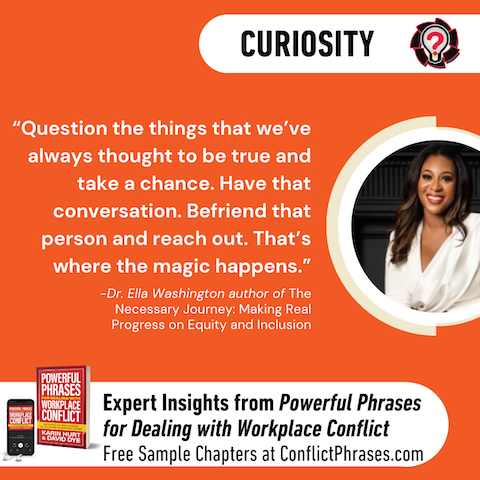
“Have you asked?”
In our podcast interview of Dr. Ella Washington, author of The Necessary Journey, she shared a wonderful story about questioning one’s assumptions.
5) Keep political conversations off message threads.
We all have bias and stereotypes. We all make assumptions. But what if we take these micro-moments every single day and question some of our own assumptions?
Fawn Weaver, the founder and CEO of Uncle Nearest Premium Whiskey, shared one of her favorite examples with me. Her husband’s family moved to Nashville from California and their next-door neighbor was a white man. He had a big truck, long beard, and tattoos. Her mother-in-law told Weaver that the man seemed like somebody who didn’t like Black people. Weaver was curious and said, “Have you asked him?”
She went next door and talked to the guy. He was very open, friendly, and was listening to some of her favorite R&B songs. That’s so inspiring.
Question the things that we’ve always thought to be true and take a chance. Have that conversation. Befriend that person and reach out. That’s where the magic happens.
“Chat and message threads are best suited to low-bandwidth conversations where there are quick transactions and not much emotion. Let’s keep the important topics and decisions in our voice-to-voice or face-to-face conversations.”
Comments and chats are horrible ways to engage in political conversations. (For proof, look at almost any comment thread on the internet – including those conversations about chickens and eggs.)
6) Share your perspective.“So, what you’re saying is . . . Do I have that right? That’s interesting. And I see it differently.”
As you listen and learn where another person comes from, first check for understanding. For example, “I hear you saying you’re concerned about your children’s future and growing up in a world where they can’t go outside without getting sick. Do I have that right?”
Then you can share your perspective—not intending to change their mind, but to contribute equally, and confidently, to the conversation.
For example, “I see what you’re saying. I’m worried about my kids’ future too. My concern is that we won’t have any work available for them because it’s gone to other countries that don’t have the same values we do.”
7) Stand up to political bullies.“We have a variety of beliefs and need different perspectives to do our best work.”
We define political bullies as people who loudly proclaim their beliefs and belittle anyone who doesn’t agree with them. This is the person who brashly proclaims, “[Candidate] is an idiot and anyone who votes for them should have their head examined.” (A direct quote from a leader in one of our prior workplaces.)
This kind of proclamation, especially from people in leadership roles, shuts down dialog, and damages trust and psychological safety. If you have a relationship with the person who made the statement, you can address it directly.
For example, “Listen, I know it might not be your intent, but saying things like that shuts down the innovation, creativity, and exchange of ideas we need. We need a variety of perspectives to do our best work and make good decisions. Saying anyone who disagrees with you should “have their head examined” does the exact opposite. And, frankly, it’s arrogant and rude.”
If you don’t have the relationship to say that, talk with your human resources professional.
8) Acknowledge differences and commit to your work together.“I don’t expect either of us to change our mind about… Can we agree to…?”
When you experience political conflict at work, you may need to create a shared agreement to help you move past the differences and focus on your work. Start by acknowledging that you both have strongly held perspectives, and it’s not about changing those. Then move to an agreement about how you’ll work together. Respecting one another’s right to hold the values you do and then work together toward a shared purpose is a powerful recipe for workplace collaboration. And you may even influence one another’s perspectives—at least a little.
Your TurnOne of the most challenging parts of being human is that our beliefs seem so “right” to us. Everything makes sense. And it feels frustrating when other people can be so (dumb, stubborn, naïve) to see it differently.
The funny thing is that when you feel that way, the other person usually does, too.
But when you can approach these differences with connection and curiosity – the awareness that there’s always more out there to know – you create the possibility of true collaboration.
See Also: Beyond the Drama: How to De-escalate and Emotional Conversation at Work.
We’d love to hear from you: what’s one of your favorite phrases to have productive conversations at work–especially the ones that could lead to political conflict?
The post How to Deal with Political Conflict at Work appeared first on Let's Grow Leaders.
February 16, 2024
Leaders Prioritizing Mental Health for Organizational Success
In this episode of the Leadership without Losing Your Soul Podcast, our guest, Chinazom Nwabueze, discusses the importance of mental health and its connection to overall wellbeing and performance. He emphasizes the need to prioritize and shares practical tips for maintaining mental fitness, such as filling up one’s emotional energy tank with activities that bring joy, practicing mindfulness, getting enough rest, and setting boundaries. Chinazom also highlights the importance of leaders modeling mental fitness and creating a culture that supports and encourages it. He suggests that leaders take breaks for mental fitness activities and show their teams that mental health is a priority. Overall, the episode emphasizes the need for individuals and organizations to prioritize mental fitness for sustainable high performance.
The Crucial ‘E’ in Mental Health and Leadership(00:00 – 03:44) This week’s podcast starts by drawing a parallel between mental health and a car’s fuel gauge, stressing the importance of proactively maintaining mental well-being before reaching a breaking point, or ‘E,’ to prevent lasting damage.
Welcome to Chinazom Nwabueze, a leadership coach who aligns mental fitness with sustained high performance, demonstrating the essential role of mental health in effective leadership. Chinazom reflects on his leadership journey, starting from childhood responsibilities to leading a team through the financial crisis, showcasing how mental health awareness can forge stronger teams.
Navigating Crisis with Authenticity(03:44 – 09:19) In a crisis, Chinazom shares his approach to leadership by being transparent about his fears, which he found to be key in building trust and team resilience. Chinazom defines mental fitness as a comprehensive approach to ensuring that leaders are equipped to handle personal and professional challenges.
Chinazom offers practical tips for leaders to maintain their mental fitness through daily routines, self-awareness, and intentional actions to fill their ’emotional energy tank.’
Cultural Shifts in Conversations(10:13 – 18:04) They delve into the cultural shifts needed to encourage open discussions on mental fitness, especially for men, to create a supportive environment that can preemptively address mental crises. The conversation advocates for ‘real talk’ among friends and colleagues to create a support network where individuals feel safe discussing these challenges.
Mental Health and Workplace Conflict(18:38 – 23:00) David shares research findings linking increased workplace conflict to mental health issues post-pandemic, indicating a rise in anxiety and depression among employees.
They discuss the whirlwind of change in recent years, from AI advancements to economic shifts, and the consequent mental health strain on individuals and leaders.
Leadership and Mental Health in the Age of AI(23:00 – 30:09) The discussion addresses how leaders must acknowledge the rapid pace of technological change and its impact, advocating for adaptability and awareness. Chinazom shares a visual tool to help people monitor their mental fitness, underscoring the daily practices that contribute to overall well-being.
A Leadership Foundation(30:09 – 39:38) Chinazom advises on the importance of self-care to prevent burnout. They discuss the discipline required to maintain mental fitness, emphasizing the need for leaders to be self-aware and to model mental health practices for their teams.
The podcast concludes with a call to action for leaders to model and promote mental health practices, cementing the idea that sustainable performance is intertwined with well-being.
Thank You To Our Guest –Connect with Chinazom Nwabueze and get his book at https://linktr.ee/realtalkmentalfitness.
 If you’d like more specific, practical phrases and approaches for common sources of workplace conflict, check out our newest book (May 2024—available for pre-order now): Powerful Phrases for Dealing with Workplace Conflict—What to say next to de-stress the workplace, build collaboration, and calm difficult customers.
If you’d like more specific, practical phrases and approaches for common sources of workplace conflict, check out our newest book (May 2024—available for pre-order now): Powerful Phrases for Dealing with Workplace Conflict—What to say next to de-stress the workplace, build collaboration, and calm difficult customers.
The post Leaders Prioritizing Mental Health for Organizational Success appeared first on Let's Grow Leaders.
February 12, 2024
Feeling Invisible? What to Say When You’re Feel Invisible or Ignored
If you feel invisible at work you’re in good company. Recent research by Work Human found that nearly 30% of workers have felt invisible at work and 27% have felt ignored.
Their research also identified certain “invisible skills” going unnoticed in the workplace. Ironically, the ignored skills are some of the most necessary for productive conflict in the workplace: empathy and compassion (27.4%), a sense of curiosity, (19.8%), and listening skills/emotional intelligence (15.4%).
I (David) had one of these invisibility experiences early in my career. I sat in a committee meeting drawing up a job description for a new senior management role. We finished the description, and the committee chair thanked us for our input. Then she said that they’d start looking for candidates the following week.
The job was interesting to me, and I immediately wondered “Why they hadn’t asked me to do it?” I sat there frustrated as the meeting concluded. And that might have been the end of the story, except for some sugar.
During college, my friends and I went to a diner whose sugar packets featured bits of rhymed wisdom. My packet had these words printed on it:
He who has a thing to sell
And goes and whispers in a well
Is not so apt to get the dollar
As he who climbs a tree and hollers.
Silly, right? But those words stuck in my head. Sitting in that committee meeting feeling overlooked, the rhyme came lilting back to mind. Challenging me to speak up for myself. I raised my hand and said, “I’m interested in this job.”
The committee chair thought about it and smiled. “You’d be a great candidate.”
I got the job. This was a powerful lesson that when you feel overlooked, you must start by seeing yourself.
Powerful Phrases to Ask Yourself If You Feel InvisibleWhat should you do when you feel like you’re wearing an invisibility cloak at work? Start by identifying when, where, and with whom you yearn for people to see you, and notice when that is, and isn’t happening. Are there consistent patterns that could show unconscious bias or discrimination? (If you suspect bias or discrimination, please contact HR, you need more than a Powerful Phrase, you need support.)
Here are a few questions to spark your thinking.
“What do people not see that I wish they would? For what do I want to be known?”Get specific to help you determine your approach. Do you wish people would see how hard you work? Then you’re going to need to find some opportunities to showcase your work and your accomplishments. Or maybe you long to have your ideas taken more seriously. In that case, you might need to change the way you’re presenting your ideas.
Another way to think about this is by completing this sentence. I wish people would know how much I __________. That’s an important first step in remedying the situation.
When you feel unseen, it might feel like it’s with everywhere and everyone. This is worth some reflection. Do you feel invisible in certain meetings or with certain people? If you feel invisible to your manager, be sure you read How to Get Your Boss to Recognize and Appreciate Your Genius.
“Is this a place where employee voice matters?”Sadly, in our Courageous Cultures research, we found some people in positions of power (we won’t call them leaders) who were happy to treat their employees like bots. They say things like, “I don’t really want them to think. Just teach them the script.” If you’ve done all you can to be seen and share your ideas, and your boss just doesn’t care, it might be time to find a new one.
Powerful Phrases to Share How You Feel or Ask for What You NeedLet’s give you some words you can use to get the attention you need and deserve.
“I’d love to set up some time to talk to you about ___ how’s Wednesday at 3?”
The best way to feel less invisible is to shine a light on the good work you’re doing. Ask for time to talk about what matters to you, to the people who should be listening.
“Sometimes, I feel isolated in my role. I’d love to explore ways to be included in discussions about ________.”
If you want people to know how you’re feeling, tell them, and ask for exactly what you need.
“Working remotely can feel lonely. Could we talk about ways we can connect more as a team?”
If you feel isolated and alone, it’s likely you’re not the only one. You don’t need to wait for your manager to bring this up.
“Would you like to grab a (real or virtual) coffee?”
If you feel isolated, invest in making some friends. Getting to know your coworkers at a personal level can go a long way in making work interesting and fun, not to mention building a network of resources you can reach out to for help.
Powerful Phrases to Get Your Voice in the ConversationAnd now a few conversation starters to break through the silence.
“I have an idea that will ______ (insert strategic benefit statement here).”
One mistake that can cause your ideas to be overlooked is a pre-apology. For example, “This is probably a bad idea.” Or, “I’m not an expert here, but…” If you want your idea to be heard, share your idea with confidence and why it matters.
“Before we leave this conversation, I have something important to add.”
This Powerful Phrase can help when you work with a group of extroverts who talk fast and hurry to the next topic. Or, if you work remotely as part of a hybrid team and feel invisible to the people in the room with one another.
When you feel invisible, dig deeper to understand where, when, and with whom you want to be seen and ask for what you need.
The post Feeling Invisible? What to Say When You’re Feel Invisible or Ignored appeared first on Let's Grow Leaders.

